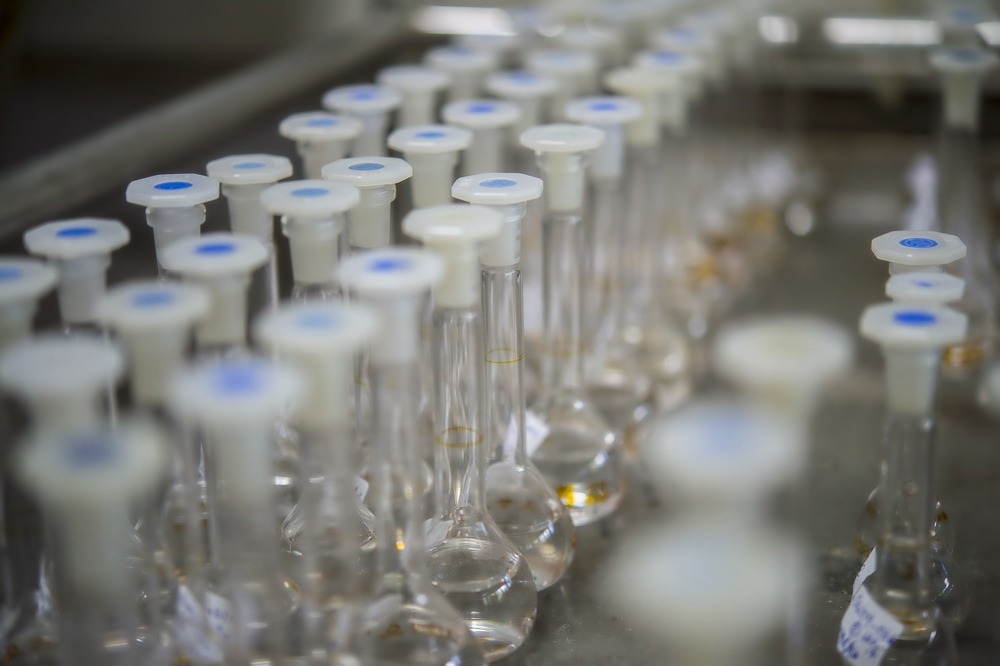Atomic and molecular absorption spectroscopies have gained widespread adoption in spectroscopic analysis due to their relatively affordable cost and operational accessibility. Although both methods involve light absorption, their underlying principles and applications differ. This article explores the difference between these spectroscopic techniques, highlighting their unique advantages, limitations, and practical applications.

Image Credit: Rabbitmindphoto/Shutterstock.com
How Does Atomic Absorption Spectroscopy Differ from Molecular Absorption Spectroscopy?
Atomic Absorption Spectroscopy
Atomic absorption spectroscopy (AAS) is used for the detection and analysis of specific elements in liquid or solid samples. Its working principle is that atoms and ions can selectively absorb light at specific wavelengths, causing electrons to jump from the ground to an excited state.
The amount of absorbed light is proportional to the concentration of the absorbing atoms or ions, which allows for determining the types of atoms present in a sample.
Molecular Absorption Spectroscopy
Molecular absorption spectroscopy (MAS), unlike atomic absorption spectroscopy, investigates the absorption of electromagnetic radiation by molecules, considering electronic transitions as well as the vibrational and rotational motions of the molecules.
When radiation passes through a sample, molecules (depending on their composition) can absorb specific wavelengths and transition to higher energy states.
By analyzing the absorbed wavelengths and their intensities, this spectroscopic technique yields valuable information about molecules' composition, structural characteristics, energy transitions, and their interaction with electromagnetic radiation.
Comparison of Applications of Atomic Absorption Spectroscopy and Molecular Absorption Spectroscopy
Atomic and molecular absorption spectroscopy have diverse and overlapping fields of application.
Atomic absorption spectroscopy aids in detecting toxic heavy metals, performing quality control in drug manufacturing, quantifying precious metals in mining operations, and analyzing drinking water for contaminants. It also finds use in analyzing trace metals in various samples, including soils, geological samples, petroleum products, and biological fluids.
On the other hand, molecular absorption spectroscopy provides valuable compositional and structural information about substances, aiding in environmental monitoring, food analysis, forensic investigations, and material characterization. It is particularly valuable in studying biomolecules, detecting biomarkers, and analyzing complex mixtures.
Comparison of Atomic and Molecular Absorption Spectra
Atomic absorption spectra consist of discrete absorption lines with dark spaces, in contrast to the continuous spectrum seen in white light passing through a prism. These spectra result from the absorption of photons during transitions from lower-energy to higher-energy states.
The narrow width of the absorption lines is determined by the fixed energy difference between ground and excited states, along with other contributing factors. The uncertainty principle governs the natural line widths, approximately 5-10 nm, while additional broadening mechanisms increase the line width to around 3-10 nm.
According to the Born-Oppenheimer approximation rule, a molecule's total energy is the sum of its constituent particles' energies, encompassing translational, vibrational, rotational, and electronic motions.
These motions give rise to molecular absorption spectra, representing transitions to higher energy levels associated with each motion, resulting in distinct spectra for each type of transition. However, translational energy is often disregarded due to its minimal contribution.
Rotational spectra (observed in microwave region) rely on angular momentum and electron spins, vibration spectra (observed in IR and Raman regions) stem from molecular vibrations due to absorbed energy, and electronic spectra (observed in UV to near-IR regions) involve electron transitions between orbitals, with certain constraints.
Comparing the Advantages and Disadvantages of Atomic Absorption Spectroscopy and Molecular Absorption Spectroscopy for Analytical Applications
Atomic absorption spectroscopy offers high accuracy, typically within a range of 0.5% to 5% and sensitivity for elemental analysis, particularly for metals. It has been instrumental in revolutionizing practices in fields like medicine and pharmaceuticals by detecting trace toxins and previously unknown elements in materials.
Atomic absorption spectroscopy is well-suited for accessing inaccessible places, such as mines, for testing rocks. Modern AAS systems are comparatively inexpensive and can accurately detect specific elements.
However, atomic absorption spectroscopy is limited to metals due to their easily readable atoms and clear absorption lines. In addition, it is a destructive analysis technique as it involves converting the sample into an atomic gas through evaporation and atomization.
On the other hand, molecular absorption spectroscopy provides structural information about molecules and has a wide range of applications. It is non-destructive, efficient, highly sensitive for trace analysis, can analyze organic and inorganic molecules, and has a larger scope of substances.
However, molecular absorption spectroscopy may face challenges due to overlapping absorption bands and lack of specificity, which can hinder accurate quantification and identification of compounds.
The choice between atomic absorption spectroscopy and molecular absorption spectroscopy depends on the specific analytical requirements. AAS is advantageous for elemental analysis and high selectivity for metals, while MAS offers insights into molecular composition and versatility across different substances.
More from AZoOptics: What is the Beer-Lambert Law and How Does It Influence Spectroscopy?
References and Further Reading
Butcher, D. J. (2013). Molecular absorption spectrometry in flames and furnaces: A review. Analytica Chimica Acta, 804, 1-15. https://doi.org/10.1016/j.aca.2013.07.056
Harvey, D. (2023). Emission and Absorbance Spectra. [Online]. LibreTexts- DePauw University. Available from: https://chem.libretexts.org/Bookshelves/Analytical_Chemistry/Instrumental_Analysis_(LibreTexts)/06%3A_An_Introduction_to_Spectrophotometric_Methods/6.04%3A_Spectra (Accessed on 28 May 2023)
İzmir Institute of Technology. (2023). An Introduction to Ultraviolet/Visible Molecular Absorption Spectrometry. [Online]. https://web.iyte.edu.tr/~serifeyalcin/lectures/chem305/cn_6.pdf (Accessed on 28 May 2023)
Izrio Filho, H. J., Santos Salazar, R. F. dos, Rosa Capri, M. da, Capri, ngelo, de Alcntara, M. A. K., & Castro Peixoto, A. L. de. (2012). State-of-the-Art and Trends in Atomic Absorption Spectrometry. InTech. https://doi.org/10.5772/26076
Michigan State University. (2023). Molecular Absorption Spectroscopy. [Online]. https://www2.chemistry.msu.edu/courses/cem434/Chapter%2013_14_molecular%20absorbance.pdf (Accessed on 28 May 2023)
Visserm, D. (2021). Atomic Absorption Spectroscopy, Principles and Applications. [Online]. Technology Networks: Analysis & Separations. Available from: https://www.technologynetworks.com/analysis/articles/atomic-absorption-spectroscopy-principles-and-applications-356829 (Accessed on 28 May 2023)
Disclaimer: The views expressed here are those of the author expressed in their private capacity and do not necessarily represent the views of AZoM.com Limited T/A AZoNetwork the owner and operator of this website. This disclaimer forms part of the Terms and conditions of use of this website.